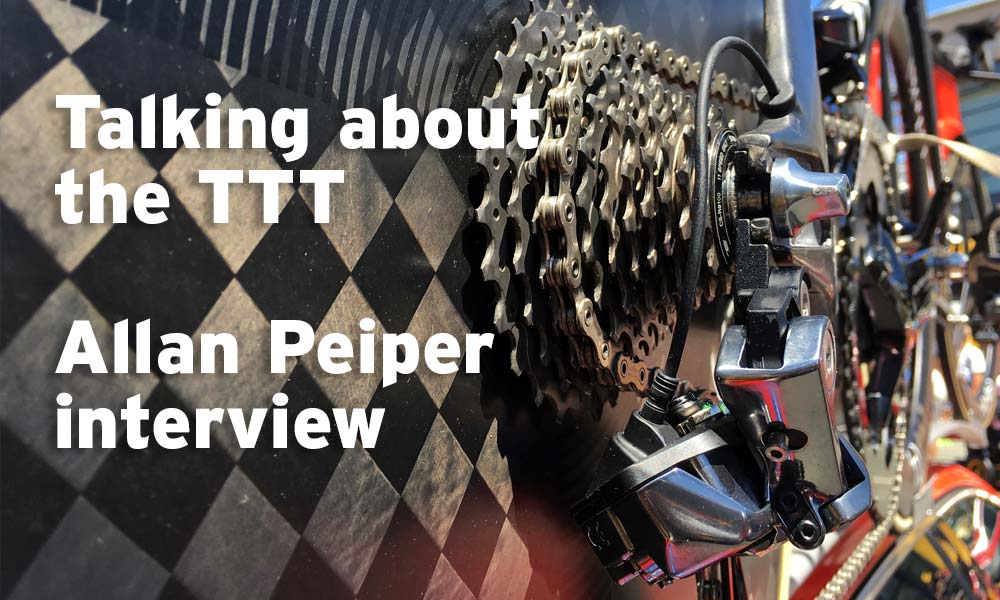[et_pb_section bb_built=”1″ admin_label=”section”][et_pb_row admin_label=”row” background_position=”top_left” background_repeat=”repeat” background_size=”initial”][et_pb_column type=”1_4″][et_pb_text use_border_color=”off” border_color=”#ffffff” border_style=”solid” _builder_version=”3.9″]
Before the start of the stage three team time trial, we caught up with a few sports directors to talk about tactics and equipment. Here is the first interview: Allan Peiper of the BMC Racing team.
[/et_pb_text][/et_pb_column][et_pb_column type=”3_4″][et_pb_text use_border_color=”off” border_color=”#ffffff” border_style=”solid” _builder_version=”3.9″]
The last time there was a team time trial at the Tour de France was in 2015 and BMC Racing set the standard. It was before the arrival of Richie Porte as the team leader for GC but many of the staff and quite a few riders remain on the roster in 2018.
We caught up with Allan Peiper before the start and asked him a few questions about gear selection, data, and the sequence of the riders.
This is a team that could very well take the yellow jersey by the end of the third stage, a 35.5km test of the collective in and around Cholet.
– Click the SoundCloud file to listen to the interview and/or read the answers from Peiper below –
[/et_pb_text][/et_pb_column][/et_pb_row][et_pb_row][et_pb_column type=”4_4″][et_pb_text _builder_version=”3.9″]
[/et_pb_text][/et_pb_column][/et_pb_row][et_pb_row][et_pb_column type=”1_4″][et_pb_text use_border_color=”off” border_color=”#ffffff” border_style=”solid” _builder_version=”3.9″]
Subscribe to RIDE Media’s SoundCloud channel and find a range of interviews about cycling…
[/et_pb_text][/et_pb_column][et_pb_column type=”3_4″][et_pb_text use_border_color=”off” border_color=”#ffffff” border_style=”solid” _builder_version=”3.9″]
Power and gear selection
“I’m feeling confident but I’m not counting the chickens before they hatch.
“I can’t really give you any [specific] numbers because there’s such a wide variation in our riders. You know, there might be times when Küng is riding at 550 watts and Richie is riding at 450, so there’s no real standardisation of that.
“We’ve chosen 58 [teeth] chainrings which I think a lot of teams have done today considering the wind and the rolling parcours, taking advantage of high speed with tailwind and downhill sections. I think that’s probably the main thing that teams are going to be going for – maximising that speed.”
[/et_pb_text][/et_pb_column][/et_pb_row][et_pb_row][et_pb_column type=”4_4″][et_pb_image animation=”left” sticky=”off” use_border_color=”off” border_color=”#ffffff” border_style=”solid” _builder_version=”3.9″ src=”https://www.ridemedia.com.au/wp-content/uploads/2018/07/BMC-01-IMG_0010.jpg” /][/et_pb_column][/et_pb_row][et_pb_row][et_pb_column type=”1_4″][et_pb_text background_layout=”light” text_orientation=”left” use_border_color=”off” border_color=”#ffffff” border_style=”solid” background_position=”top_left” background_repeat=”repeat” background_size=”initial”]
Caption
[/et_pb_text][/et_pb_column][et_pb_column type=”3_4″][et_pb_text use_border_color=”off” border_color=”#ffffff” border_style=”solid” _builder_version=”3.9″]
Working out the sequence of riders
“Küng is a great time triallist – and a great team time triallist – but you don’t win a team time trial with one rider. It’s your sum total that counts and it’s getting the maximum out of those seventh and eighth riders, taking them all the way to the finish – or as far as possible, and maximising their energy that wins the bike race.
“Consider Richie Porte, you know: we’ve built a team around him that takes him into consideration so with the line-up [position in the sequence of riders]… the guys in front of him and behind him so that the tempo is not changing too much and, of course, compared to Küng, [Porte] his turns will be a lot shorter.”
[/et_pb_text][/et_pb_column][/et_pb_row][et_pb_row][et_pb_column type=”4_4″][et_pb_image animation=”left” sticky=”off” use_border_color=”off” border_color=”#ffffff” border_style=”solid” _builder_version=”3.9″ src=”https://www.ridemedia.com.au/wp-content/uploads/2018/07/BMC-02-IMG_0004.jpg” /][/et_pb_column][/et_pb_row][et_pb_row][et_pb_column type=”1_4″][et_pb_text use_border_color=”off” border_color=”#ffffff” border_style=”solid” _builder_version=”3.9″]
Like many other riders in Cholet, Richie Porte will be racing with a 58 tooth chainring.
Photo: Rob Arnold
[/et_pb_text][/et_pb_column][et_pb_column type=”3_4″][et_pb_text use_border_color=”off” border_color=”#ffffff” border_style=”solid” _builder_version=”3.9″]
What’s the typical length of a turn at the front?
“Those are details I’m not going to give you… but it is a lot of fine-tuning. It goes on power and the potential of each rider and, of course, the motors like Stefan Küng and Patty Bevin are the ones that set the pace and everybody else in the team basically rides to their capacity of their potential.
“That could be five seconds or 10 seconds or 15 seconds – depending on the part of the parcours as well. If it’s uphill, it might be shorter and if it’s downhill, it might be a fraction longer.”
– Interview by Rob Arnold
[/et_pb_text][/et_pb_column][/et_pb_row][et_pb_row][et_pb_column type=”4_4″][et_pb_image animation=”left” sticky=”off” use_border_color=”off” border_color=”#ffffff” border_style=”solid” _builder_version=”3.9″ src=”https://www.ridemedia.com.au/wp-content/uploads/2018/07/BMC-01-IMG_0005.jpg” /][/et_pb_column][/et_pb_row][/et_pb_section]



